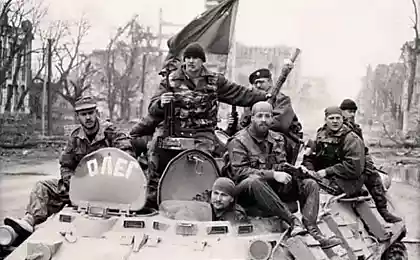1884
History of the USSR from Family Albums 60s - 70s (50 photos + text)
Photos from family albums of the period of “stagnation” of the USSR, some call it the heyday, someone “developed socialism”, but nevertheless, people lived like this and considered it important for themselves to preserve these moments. People were just like in the pictures.
New Year's performance. New 1960.
Perhaps the most striking difference between the USSR and all other societies was the joyous belief that “tomorrow will be better than yesterday.”

The new society was doing the seemingly impossible in principle - a world leader in space, nuclear energy, education... a twice-built country. People dreamed of space trails and knew it was possible. The boys of the USSR usually knew perfectly well what a “white dwarf”, a neutron star, a black hole and through one dreamed of a career not as a banker, but as a pioneer astronaut. It's a Kremlin tree.
A year later, Gagarin will fly. May 9, 1960 Welsk. Veteran Bragin.
Just 15 years after the war. Two orders of the "Red Star" and two "War of the Fatherland" - 1 and 2 degrees: the veteran Bragin fought with dignity.
In almost every family, someone fought, in many of them one of the relatives died. I remember the 70s - in our entrance of 15 apartments lived 5 veterans, they were all 50 years old or more. In the whole house of a hundred apartments there were somewhere 40-50 people. On Victory Day, they went out into the yard, ringing medals, then went to the military cemetery nearby, used to sit in the yard on a bench, some “missed a pile”, then went home to the table. It was a family holiday and guests were not usually invited. Russians do not like to arrange such things in public. Father did not like to talk about the War, but on Victory Day he began to remember how it was – the Kursk Bulge, the Dnieper.
Then they began to convince us with foam at our mouths that “tens of millions” were sitting in camps, that “someone sat in every family and was afraid to admit it.” Then the “victims of repression,” that is, the old criminals and their family members, were compensated – it became profitable to be a “victim of Stalinism.” But somehow it turns out that we had almost no innocent victims. In the whole house, one person per hundred apartments.

Hunter. Welsk. 1960
Buying a hunting or small-caliber weapon until the end of the 50s was very simple - come to the store and buy. Then it was a little more difficult - a hunting ticket was required, then even more difficult. For some reason, the closer to “perestroika”, the more difficult it became with weapons. And the easiest with hunting and other weapons was under Stalin.
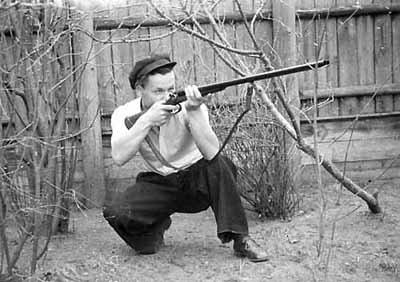
At the May Day demonstration. 1961
They were really happy, singing songs, dancing to the harmonica. Just like the KGB and the desk com would make people smile for family albums.
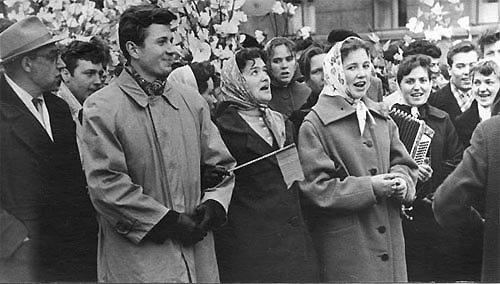
Fidel. Irkutsk 1961
Rare is a private photograph of Fidel in the USSR. It is interesting how sharply his face differs from the muzzles of the party bosses of the regional spill that began to degenerate. But so far, it hasn't been particularly annoying. This is the year Gagarin flew.

New Year. Kindergarten 1967
The best kindergartens in the world. No exaggeration. With thought-out scientific systems and norms of nutrition, preschool education, regime, education, specially designed toys. Children’s holidays, mornings, and the most favorite holiday is the New Year. Of course, Santa Claus.
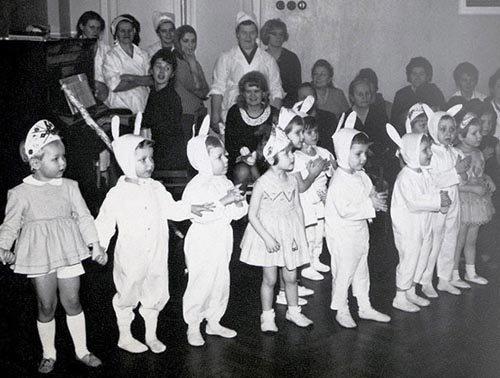
New Year in Kindergarten. 60s.
In every kindergarten there was a children's doctor, nannies, cleaners, cooks ...
This is not even close in kindergartens, for example, in America or Canada. On the contrary – poor nutrition, unsanitary, when sick children sleep on the floor on the litter next to healthy – yes, there are no bedrooms, as in our kindergartens. The piano's definitely not there.

Goalkeeper. 1966 1966
Now we are trying to explain that the children were not dressed in anything.

Sled. 1967
A six-year-old could walk alone without fear. In civilized countries, it is forbidden not only to let one walk, but even to leave unattended up to 12 years under the threat that the child will be taken away from his parents. This is strangely called “democracy” and, even more strangely, “free” citizens do not protest and swallow without squeaking. And in the USSR it was simply unthinkable savagery, the same as we think cannibalism in the Papuans and children grew up normal and healthy, and telezombies raised by comics and duroscope.

kindergarten. Nevelsk 1970
It is now kindergarten teachers living in poverty, and then it was a very worthy, important and interesting profession. Teachers wrote magazines by profession, constantly learned new methods of education and education. In a word, totalitarianism. Now there is something to compare.
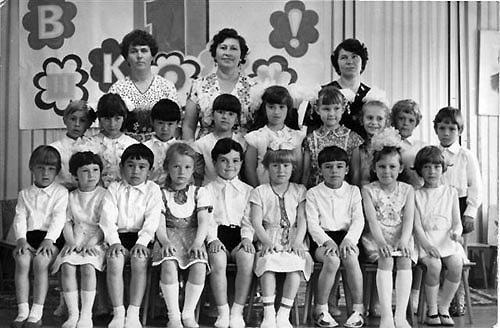
kindergarten. Game at the Store. 70s
Shop game. Surprisingly, not in telebubbles, monsters or brats, and children are very happy. Kindergartens were very cheap, and sometimes nothing at all. Therefore, raising children was not a special problem — the mother could easily work or study, when the education, nutrition and upbringing of her child were engaged in professionals.

"The Horse" 1971

First class. 1966 1966
The best education in the world for everyone. A single, well-designed and well-standardized system. It is in the West that ambitious ignoramuses with fragmentary unsystematic knowledge are released, and with "totalitarianism" for some reason care is taken about the harmony of a person - not only knowledge is important, but also the ability to think, the soul of a person and his physical perfection. No one in the world had such a wealth of world literature, such a depth of knowledge of world history. The project of the USSR was based on the maximum possible development of each person. Of course, not everything was possible to do, especially when you consider the starting level of “Russia-which-they-lost”, but the progress was tremendous. The education of the USSR was built on seeing the best in people. This, on the one hand, is beautiful, but on the other, it turns into an inadequacy of perception. We thought of people better than they are. We made up our ideas, for example, about the Anglo-Saxons, Germans and French on the basis of acquaintance with the best examples of their creativity and history. It helped us cheat... The reality is much more unsightly. A lesson for the future.

1st Class 1966
What is the fate of these wonderful girls now?

1 September at GSVG 70s
The GSVG (Group of Soviet Troops in Germany), the same one that was feared before convulsions in the West. The town is the children of those who served and worked there.
This party elite started a moronic song about the “struggle for peace”, tuned in to the surrender of the country. And people like this officer with orders slats sang other songs, "We've been with you half the world, if necessary - repeat." And the "probable friends" knew clearly: if necessary, they will repeat. Therefore, they squealed about the “Soviet threat”.

First call. 1970
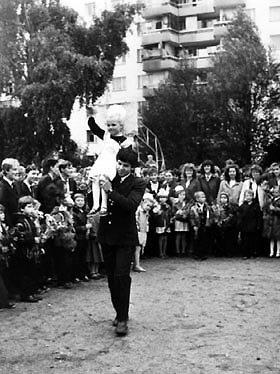
School competitions. Moscow, 1975
It was really great, especially the game of Zarnitsa.
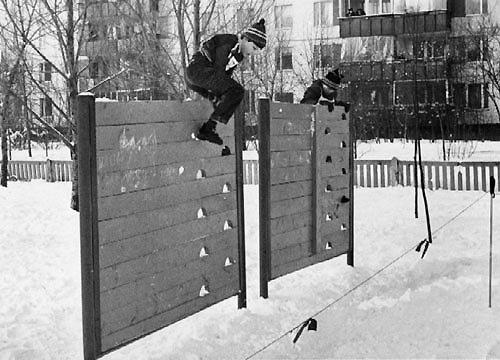
Physical education in the school pool. 1976
Schools began to appear, furnished with the latest word of pedagogical science. Swimming pools, beautiful gyms, mugs, the best educational films in the world, equipment in physics rooms and reagents in chemistry rooms - for each student. This is still not the case in the West, and it will not happen with their education system.
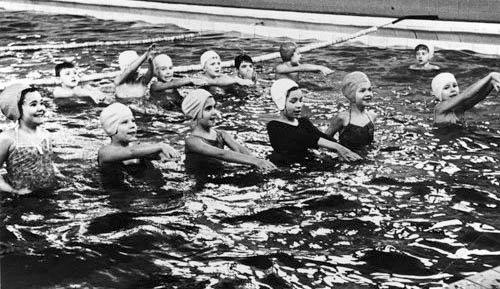
Pioneer. 1967
Pioneer camp is almost free for parents. Well-thought-out system of rest and education - sports, rest, work, circles and sections right there. For everyone. This has never happened anywhere in the world.

Factory Pioneer Camp. 1965 1965
Pioneering fires and friendship remember everything.

Potatoes. 60s.
The agrarian country was turning into an industrial country at a rate unprecedented in history, the natural, rural population was to decrease sharply, and the urban population was to increase just as sharply. If in the 20s about 85-90% of the population lived in the village, then in the 70s the urban population began to make up more than 60%, and the most rural residents lived in Central Asia. Despite the huge increase in productivity in agriculture as a result of mechanization and chemicalization, it still required a large share of manual labor for harvesting. It is Russia, not America, where you can rent two or three crops a year, not to keep specially seasonal workers for this. Russia has always required large acreage in our harsh climate, and productivity in our climate will always be lower, all other things being equal.
Therefore, the right decision was made to use urban residents for seasonal harvesting of certain crops. At that level of development of the productive forces, there was no other way. Another thing is that it was ideologically arranged completely wrong, the authorities were as if shy, and it was necessary to make this a widely advertised show plus competent management of labor resources. And it is very useful for the citizen to see with his own eyes where the products come from, that they are not grown packaged in the store.
None of the normal people from trips to the collective farm did the tragedy, on the contrary – it was very funny. As a student and student, I loved it. However, there are some who “still cannot forgive...” Forgive what? All.

Angarsk 1970
High school.
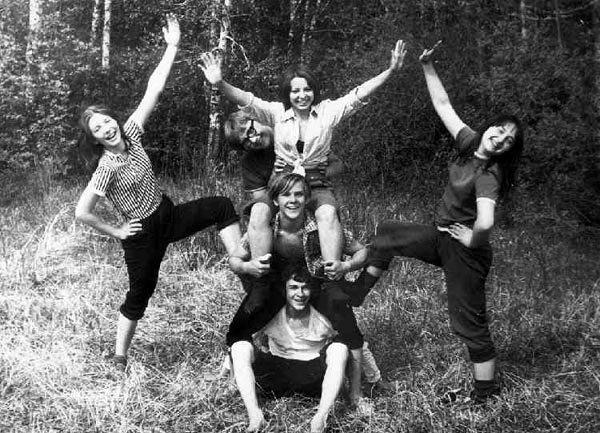
School Group. Angarsk 1970
In our school there was a very similar picture - the guys played in the assembly hall.
There were also school groups, at school discotheques "spun" "The Beatles" and Western music, and domestic was very good. Even Marx and Lenin were not a hindrance on the walls.
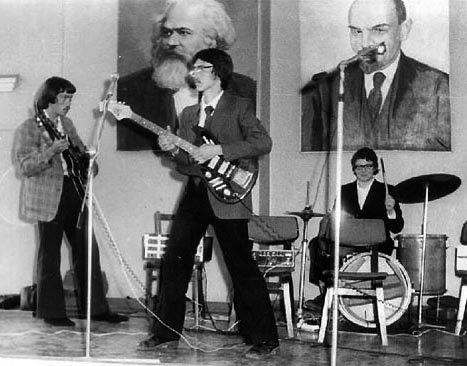
School holiday. Angarsk 1970
School holiday. Now they are trying to explain to us that we, it turns out, did not have shoes, and women’s boots and tights could not be bought in principle. For some reason, looking at the photos of that time, one becomes convinced that this is not true.

School Saturday. Angarsk 1970
"The Horrors of Soviet Totalitarianism" © School Saturday - cleaning the territory. Sneakers in the USSR, too, of course, was not. Look at the faces of teenagers, are they happy? No way! No Coke or pornography? It was believed that the formation of the habit of work is an extremely important part of the development of the human personality. That's a good idea.
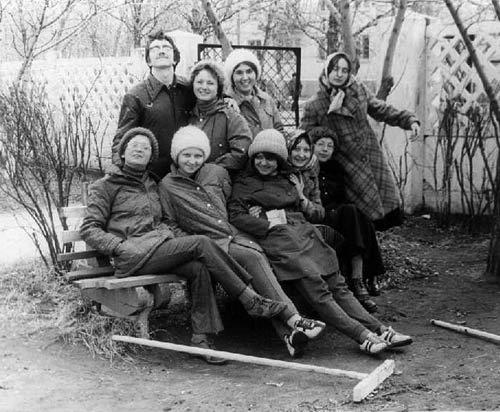
Guitarist. 70s
There were no drugs. I mean, at all. I heard that somewhere in the “civilized countries”.
And now every year, 70,000 of these boys and girls are killed by drugs — five times more than in the 10 years of the Afghan war.

On the river. 70s
They did it themselves, without adults.
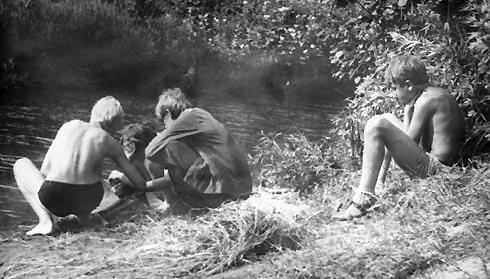
"Vovka, come out!" Nevelsk 70s
They were screaming straight from the street. It was possible to simply “run” to the neighbor.

Boys. Nevelsk 70s
Yeah, we were like this. No problem running to the forest, to the river, to the construction site. No maniacs and half-drunk junk.

On NDP. 70s
Why the girl joins the store when the champole is put forward is unclear. This is a holiday (white festive apron), maybe she should stand on the guard of honor? But why take out the shoe?! Girls with guns and equipment are often at odds.

Last call. 70s

First Meeting of Classmates 1977
How different are the faces from the current... For the better. Another state of mind in humans.

Student Irina Tarasova, national team of the USSR 70th
An ordinary student became a member of the USSR national athletics team. The sport was massive, many boys and girls became Masters of Sport and Candidates for the Master, not to mention sports categories. Many managed to practice in several sections, choosing a sport to their liking. Sections were free, in some sometimes paid, but very little.
Youth, late '70s
Ordinary boys and girls, not "majors." It is terrible to imagine – in jeans, “which in the USSR was not”, as we are now told in the duroscope.

Guys. 1976 1976
Then it was fashionable for a guy to walk with a “transistor”.

Hike. Moscow 60s
How did people live when they rested and had fun? Like this. Now, probably, there is no way to pass - the fences of the "new Russians" - scum who stole the future from us and our children. When you see old photos, you compare “what happened and what happened.”

Apartment. 70s
Yeah, that's the kind of apartment. These are clearly not party workers, ordinary workers. Almost the same apartments were my friends, and exactly the same shelves “ladder” himself hung in the 80th, I was then 14, only the antenna we had was not decimeter, and “horned” and the chandelier is very similar. Television in the '70s was usually not colored, but black and white.

Moscow 70s
Apparently, cooking sells cutting - the tray was put out on the street to sell faster. Now all sorts of liars and scoundrels are very fond of telling how in the USSR it was bad with food and "nothing could be bought." I remember perfectly well that meat without any problems could be bought in those years in cooking or in the market - more expensive, but always without a queue, and sausage - in the cooptorg. Shop meat often had a lot of bones and it did not always happen. For those who want market prices, welcome to the market, cooking or co-optorg. Chickens are always in the store, fish is always ice cream, fresh 1-2 times a week. There were no serious nutritional problems. This is not Moscow at all, I had to live in several cities, and my parents were not from the party menklatura at all. Problems with products began to appear much later - from the 80s, and by the 90s they acquired the clear appearance of a well-designed economic sabotage.

The training vessel of the Kropotkin Seafarer. Baturin 70s
The USSR did not spare funds and efforts for secondary special education, so there were real specialists.
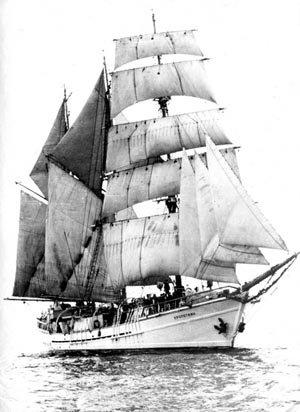
Test pilot Vladimir Klimenok. Primorye 70s
How does the face differ from the “faces” of modern “effective managers”?

Geologists of Transbaikalia. 1966 1966
So, someone built a country, developed wild lands and dreamed of exploring Mars, and someone kept fig in his pocket, out of malice. So who was happy? The vast majority of deposits were discovered in the USSR, and after its destruction, almost nothing was discovered.
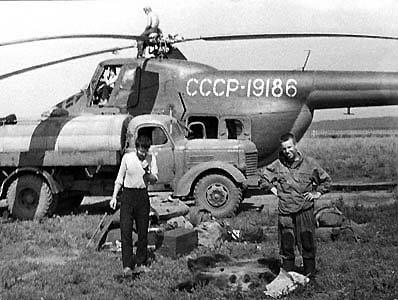
Abramov Glacier. 1970
Meteorological and glaciological station. In the USSR, the most active research was conducted to prevent and predict natural disasters, including such dangerous and unpredictable as earthquakes, avalanches and mudflows. Geologists, geographers, mathematicians, physicists worked on complex problems...

A solemn building. Catherine's Harbor. Kostrichenko. 60s.

Oath. 70s
“I, a citizen of the Union of Soviet Socialist Republics, when I join the ranks of the Armed Forces, take the oath and solemnly swear to be an honest, brave, disciplined, vigilant warrior, to strictly preserve military and state secrets, to unquestioningly obey all military regulations and orders of commanders and commanders. I swear to study military affairs conscientiously, to protect military and people’s property in every possible way, and to be devoted to my People, my Soviet Motherland and the Soviet Government to the last breath. I am always ready, on the orders of the Soviet Government, to defend my Motherland, the Union of Soviet Socialist Republics, and, as a soldier of the Armed Forces, I swear to defend it courageously, skillfully, with dignity and honor, sparing my blood and life itself for the achievement of complete victory over the enemies. But if I break this solemn oath of mine, let me suffer the severe punishment of Soviet law, the universal hatred and contempt of my comrades.
For comparison, from the “Russian” oath: “If I violate the military oath I took, I am ready to bear the responsibility established by the laws of the Russian Federation.”

Topography. Uzbekistan 70s
Before the builders are topographers – soon in the wild steppe will begin the construction of modern industry and housing.
In Soviet times, Uzbekistan turned from a backward semi-feudal Asian suburb into a developed industrial-agrarian republic with a developed light and food industry, heavy industry grew ten times. Powerful power plants were built, gas and oil fields were opened and developed. Heavy, electrical, radio-electronic, instrument-making, aviation, chemical, light and food industries appeared. On the basis of large industrial enterprises, new cities arose and old ones were reconstructed: Chirchik, Bekabad, Kattakurgan.

Moscow. Damn it. New buildings. 1970
Only by the 70s began to fade into the past the consequences of the war. When it was finally possible to build not rocket plants – the country was reliably covered by a nuclear shield to protect itself from “democratizers”, but mass housing.
We built a lot of them all over the country.
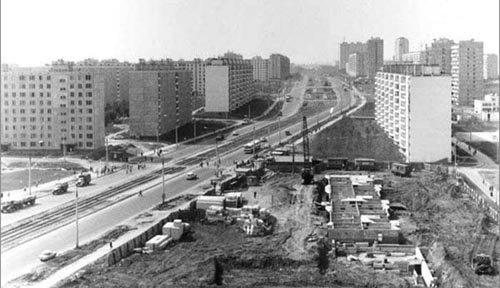
Moscow. New buildings Yasenevo. 70s
We, the children of those years, spent our childhood on construction sites – they were everywhere.
Running from the guards guarding the construction, it was fun, but a bit risky - you could get the ass.
It was especially interesting to play hide-and-seek or hack a team on wooden tomahawks in a brick five-story building, where the walls between the entrances were not fully erected and the house was a kind of labyrinth. In high-rise buildings it was not so interesting - concrete slabs for walls were put immediately.
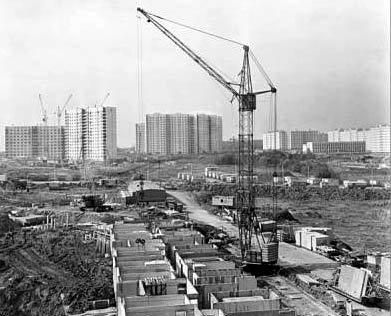
Moscow Microdistrict. 70s
When the neighborhood was built, it was planned in advance. According to the plan, a school, a kindergarten, shops, hairdressers were built, transport routes were carried out, trees were planted in squares. "Pinpoint building" was impossible. In principle, it was impossible to throw a person out of the apartment on the street.
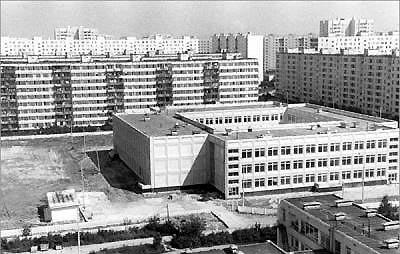
Sakhalin. Port Nevelsk. 70s
Port city, one of many new cities built in the USSR. Population of the rich lands of the Far East.

North Flight. Krivoshlikov 70s
The Northern Sea Route is the main highway in the Arctic with a length of more than 5500 km, connecting the European part of Russia with the Far East, otherwise you will have to go through the Suez Canal, and this is two and a half times further. The Northern Sea Route was the largest transport achievement of the USSR - it, without exaggeration, transformed the life of the North of the country and the Far East. According to it, equipment, fuel, food are transported to the North, and from there minerals and forest. Thanks to the Northern Sea Route, the Siberian rivers “earned” – it became possible to raft forests and other cargoes into the Arctic Ocean. After the “liberation of the country from totalitarianism” and the rise to the “pillar road of civilization”, the volume of traffic fell 6 times.
Navigation is short – on average only 3 months a year, but it began to be extended in the USSR with the help of powerful icebreakers. The conditions are very harsh and work so very persistent and skilled professionals. Such will still be needed, but not now, but a new, totalitarian one. Russia.

Pavel Krasnov
Russian Project
New Year's performance. New 1960.
Perhaps the most striking difference between the USSR and all other societies was the joyous belief that “tomorrow will be better than yesterday.”

The new society was doing the seemingly impossible in principle - a world leader in space, nuclear energy, education... a twice-built country. People dreamed of space trails and knew it was possible. The boys of the USSR usually knew perfectly well what a “white dwarf”, a neutron star, a black hole and through one dreamed of a career not as a banker, but as a pioneer astronaut. It's a Kremlin tree.
A year later, Gagarin will fly. May 9, 1960 Welsk. Veteran Bragin.
Just 15 years after the war. Two orders of the "Red Star" and two "War of the Fatherland" - 1 and 2 degrees: the veteran Bragin fought with dignity.
In almost every family, someone fought, in many of them one of the relatives died. I remember the 70s - in our entrance of 15 apartments lived 5 veterans, they were all 50 years old or more. In the whole house of a hundred apartments there were somewhere 40-50 people. On Victory Day, they went out into the yard, ringing medals, then went to the military cemetery nearby, used to sit in the yard on a bench, some “missed a pile”, then went home to the table. It was a family holiday and guests were not usually invited. Russians do not like to arrange such things in public. Father did not like to talk about the War, but on Victory Day he began to remember how it was – the Kursk Bulge, the Dnieper.
Then they began to convince us with foam at our mouths that “tens of millions” were sitting in camps, that “someone sat in every family and was afraid to admit it.” Then the “victims of repression,” that is, the old criminals and their family members, were compensated – it became profitable to be a “victim of Stalinism.” But somehow it turns out that we had almost no innocent victims. In the whole house, one person per hundred apartments.

Hunter. Welsk. 1960
Buying a hunting or small-caliber weapon until the end of the 50s was very simple - come to the store and buy. Then it was a little more difficult - a hunting ticket was required, then even more difficult. For some reason, the closer to “perestroika”, the more difficult it became with weapons. And the easiest with hunting and other weapons was under Stalin.

At the May Day demonstration. 1961
They were really happy, singing songs, dancing to the harmonica. Just like the KGB and the desk com would make people smile for family albums.

Fidel. Irkutsk 1961
Rare is a private photograph of Fidel in the USSR. It is interesting how sharply his face differs from the muzzles of the party bosses of the regional spill that began to degenerate. But so far, it hasn't been particularly annoying. This is the year Gagarin flew.

New Year. Kindergarten 1967
The best kindergartens in the world. No exaggeration. With thought-out scientific systems and norms of nutrition, preschool education, regime, education, specially designed toys. Children’s holidays, mornings, and the most favorite holiday is the New Year. Of course, Santa Claus.

New Year in Kindergarten. 60s.
In every kindergarten there was a children's doctor, nannies, cleaners, cooks ...
This is not even close in kindergartens, for example, in America or Canada. On the contrary – poor nutrition, unsanitary, when sick children sleep on the floor on the litter next to healthy – yes, there are no bedrooms, as in our kindergartens. The piano's definitely not there.

Goalkeeper. 1966 1966
Now we are trying to explain that the children were not dressed in anything.

Sled. 1967
A six-year-old could walk alone without fear. In civilized countries, it is forbidden not only to let one walk, but even to leave unattended up to 12 years under the threat that the child will be taken away from his parents. This is strangely called “democracy” and, even more strangely, “free” citizens do not protest and swallow without squeaking. And in the USSR it was simply unthinkable savagery, the same as we think cannibalism in the Papuans and children grew up normal and healthy, and telezombies raised by comics and duroscope.

kindergarten. Nevelsk 1970
It is now kindergarten teachers living in poverty, and then it was a very worthy, important and interesting profession. Teachers wrote magazines by profession, constantly learned new methods of education and education. In a word, totalitarianism. Now there is something to compare.

kindergarten. Game at the Store. 70s
Shop game. Surprisingly, not in telebubbles, monsters or brats, and children are very happy. Kindergartens were very cheap, and sometimes nothing at all. Therefore, raising children was not a special problem — the mother could easily work or study, when the education, nutrition and upbringing of her child were engaged in professionals.

"The Horse" 1971

First class. 1966 1966
The best education in the world for everyone. A single, well-designed and well-standardized system. It is in the West that ambitious ignoramuses with fragmentary unsystematic knowledge are released, and with "totalitarianism" for some reason care is taken about the harmony of a person - not only knowledge is important, but also the ability to think, the soul of a person and his physical perfection. No one in the world had such a wealth of world literature, such a depth of knowledge of world history. The project of the USSR was based on the maximum possible development of each person. Of course, not everything was possible to do, especially when you consider the starting level of “Russia-which-they-lost”, but the progress was tremendous. The education of the USSR was built on seeing the best in people. This, on the one hand, is beautiful, but on the other, it turns into an inadequacy of perception. We thought of people better than they are. We made up our ideas, for example, about the Anglo-Saxons, Germans and French on the basis of acquaintance with the best examples of their creativity and history. It helped us cheat... The reality is much more unsightly. A lesson for the future.

1st Class 1966
What is the fate of these wonderful girls now?

1 September at GSVG 70s
The GSVG (Group of Soviet Troops in Germany), the same one that was feared before convulsions in the West. The town is the children of those who served and worked there.
This party elite started a moronic song about the “struggle for peace”, tuned in to the surrender of the country. And people like this officer with orders slats sang other songs, "We've been with you half the world, if necessary - repeat." And the "probable friends" knew clearly: if necessary, they will repeat. Therefore, they squealed about the “Soviet threat”.

First call. 1970

School competitions. Moscow, 1975
It was really great, especially the game of Zarnitsa.

Physical education in the school pool. 1976
Schools began to appear, furnished with the latest word of pedagogical science. Swimming pools, beautiful gyms, mugs, the best educational films in the world, equipment in physics rooms and reagents in chemistry rooms - for each student. This is still not the case in the West, and it will not happen with their education system.

Pioneer. 1967
Pioneer camp is almost free for parents. Well-thought-out system of rest and education - sports, rest, work, circles and sections right there. For everyone. This has never happened anywhere in the world.

Factory Pioneer Camp. 1965 1965
Pioneering fires and friendship remember everything.

Potatoes. 60s.
The agrarian country was turning into an industrial country at a rate unprecedented in history, the natural, rural population was to decrease sharply, and the urban population was to increase just as sharply. If in the 20s about 85-90% of the population lived in the village, then in the 70s the urban population began to make up more than 60%, and the most rural residents lived in Central Asia. Despite the huge increase in productivity in agriculture as a result of mechanization and chemicalization, it still required a large share of manual labor for harvesting. It is Russia, not America, where you can rent two or three crops a year, not to keep specially seasonal workers for this. Russia has always required large acreage in our harsh climate, and productivity in our climate will always be lower, all other things being equal.
Therefore, the right decision was made to use urban residents for seasonal harvesting of certain crops. At that level of development of the productive forces, there was no other way. Another thing is that it was ideologically arranged completely wrong, the authorities were as if shy, and it was necessary to make this a widely advertised show plus competent management of labor resources. And it is very useful for the citizen to see with his own eyes where the products come from, that they are not grown packaged in the store.
None of the normal people from trips to the collective farm did the tragedy, on the contrary – it was very funny. As a student and student, I loved it. However, there are some who “still cannot forgive...” Forgive what? All.

Angarsk 1970
High school.

School Group. Angarsk 1970
In our school there was a very similar picture - the guys played in the assembly hall.
There were also school groups, at school discotheques "spun" "The Beatles" and Western music, and domestic was very good. Even Marx and Lenin were not a hindrance on the walls.

School holiday. Angarsk 1970
School holiday. Now they are trying to explain to us that we, it turns out, did not have shoes, and women’s boots and tights could not be bought in principle. For some reason, looking at the photos of that time, one becomes convinced that this is not true.

School Saturday. Angarsk 1970
"The Horrors of Soviet Totalitarianism" © School Saturday - cleaning the territory. Sneakers in the USSR, too, of course, was not. Look at the faces of teenagers, are they happy? No way! No Coke or pornography? It was believed that the formation of the habit of work is an extremely important part of the development of the human personality. That's a good idea.

Guitarist. 70s
There were no drugs. I mean, at all. I heard that somewhere in the “civilized countries”.
And now every year, 70,000 of these boys and girls are killed by drugs — five times more than in the 10 years of the Afghan war.

On the river. 70s
They did it themselves, without adults.

"Vovka, come out!" Nevelsk 70s
They were screaming straight from the street. It was possible to simply “run” to the neighbor.

Boys. Nevelsk 70s
Yeah, we were like this. No problem running to the forest, to the river, to the construction site. No maniacs and half-drunk junk.

On NDP. 70s
Why the girl joins the store when the champole is put forward is unclear. This is a holiday (white festive apron), maybe she should stand on the guard of honor? But why take out the shoe?! Girls with guns and equipment are often at odds.

Last call. 70s

First Meeting of Classmates 1977
How different are the faces from the current... For the better. Another state of mind in humans.

Student Irina Tarasova, national team of the USSR 70th
An ordinary student became a member of the USSR national athletics team. The sport was massive, many boys and girls became Masters of Sport and Candidates for the Master, not to mention sports categories. Many managed to practice in several sections, choosing a sport to their liking. Sections were free, in some sometimes paid, but very little.
Youth, late '70s
Ordinary boys and girls, not "majors." It is terrible to imagine – in jeans, “which in the USSR was not”, as we are now told in the duroscope.

Guys. 1976 1976
Then it was fashionable for a guy to walk with a “transistor”.

Hike. Moscow 60s
How did people live when they rested and had fun? Like this. Now, probably, there is no way to pass - the fences of the "new Russians" - scum who stole the future from us and our children. When you see old photos, you compare “what happened and what happened.”

Apartment. 70s
Yeah, that's the kind of apartment. These are clearly not party workers, ordinary workers. Almost the same apartments were my friends, and exactly the same shelves “ladder” himself hung in the 80th, I was then 14, only the antenna we had was not decimeter, and “horned” and the chandelier is very similar. Television in the '70s was usually not colored, but black and white.

Moscow 70s
Apparently, cooking sells cutting - the tray was put out on the street to sell faster. Now all sorts of liars and scoundrels are very fond of telling how in the USSR it was bad with food and "nothing could be bought." I remember perfectly well that meat without any problems could be bought in those years in cooking or in the market - more expensive, but always without a queue, and sausage - in the cooptorg. Shop meat often had a lot of bones and it did not always happen. For those who want market prices, welcome to the market, cooking or co-optorg. Chickens are always in the store, fish is always ice cream, fresh 1-2 times a week. There were no serious nutritional problems. This is not Moscow at all, I had to live in several cities, and my parents were not from the party menklatura at all. Problems with products began to appear much later - from the 80s, and by the 90s they acquired the clear appearance of a well-designed economic sabotage.

The training vessel of the Kropotkin Seafarer. Baturin 70s
The USSR did not spare funds and efforts for secondary special education, so there were real specialists.

Test pilot Vladimir Klimenok. Primorye 70s
How does the face differ from the “faces” of modern “effective managers”?

Geologists of Transbaikalia. 1966 1966
So, someone built a country, developed wild lands and dreamed of exploring Mars, and someone kept fig in his pocket, out of malice. So who was happy? The vast majority of deposits were discovered in the USSR, and after its destruction, almost nothing was discovered.

Abramov Glacier. 1970
Meteorological and glaciological station. In the USSR, the most active research was conducted to prevent and predict natural disasters, including such dangerous and unpredictable as earthquakes, avalanches and mudflows. Geologists, geographers, mathematicians, physicists worked on complex problems...

A solemn building. Catherine's Harbor. Kostrichenko. 60s.

Oath. 70s
“I, a citizen of the Union of Soviet Socialist Republics, when I join the ranks of the Armed Forces, take the oath and solemnly swear to be an honest, brave, disciplined, vigilant warrior, to strictly preserve military and state secrets, to unquestioningly obey all military regulations and orders of commanders and commanders. I swear to study military affairs conscientiously, to protect military and people’s property in every possible way, and to be devoted to my People, my Soviet Motherland and the Soviet Government to the last breath. I am always ready, on the orders of the Soviet Government, to defend my Motherland, the Union of Soviet Socialist Republics, and, as a soldier of the Armed Forces, I swear to defend it courageously, skillfully, with dignity and honor, sparing my blood and life itself for the achievement of complete victory over the enemies. But if I break this solemn oath of mine, let me suffer the severe punishment of Soviet law, the universal hatred and contempt of my comrades.
For comparison, from the “Russian” oath: “If I violate the military oath I took, I am ready to bear the responsibility established by the laws of the Russian Federation.”

Topography. Uzbekistan 70s
Before the builders are topographers – soon in the wild steppe will begin the construction of modern industry and housing.
In Soviet times, Uzbekistan turned from a backward semi-feudal Asian suburb into a developed industrial-agrarian republic with a developed light and food industry, heavy industry grew ten times. Powerful power plants were built, gas and oil fields were opened and developed. Heavy, electrical, radio-electronic, instrument-making, aviation, chemical, light and food industries appeared. On the basis of large industrial enterprises, new cities arose and old ones were reconstructed: Chirchik, Bekabad, Kattakurgan.

Moscow. Damn it. New buildings. 1970
Only by the 70s began to fade into the past the consequences of the war. When it was finally possible to build not rocket plants – the country was reliably covered by a nuclear shield to protect itself from “democratizers”, but mass housing.
We built a lot of them all over the country.

Moscow. New buildings Yasenevo. 70s
We, the children of those years, spent our childhood on construction sites – they were everywhere.
Running from the guards guarding the construction, it was fun, but a bit risky - you could get the ass.
It was especially interesting to play hide-and-seek or hack a team on wooden tomahawks in a brick five-story building, where the walls between the entrances were not fully erected and the house was a kind of labyrinth. In high-rise buildings it was not so interesting - concrete slabs for walls were put immediately.

Moscow Microdistrict. 70s
When the neighborhood was built, it was planned in advance. According to the plan, a school, a kindergarten, shops, hairdressers were built, transport routes were carried out, trees were planted in squares. "Pinpoint building" was impossible. In principle, it was impossible to throw a person out of the apartment on the street.

Sakhalin. Port Nevelsk. 70s
Port city, one of many new cities built in the USSR. Population of the rich lands of the Far East.

North Flight. Krivoshlikov 70s
The Northern Sea Route is the main highway in the Arctic with a length of more than 5500 km, connecting the European part of Russia with the Far East, otherwise you will have to go through the Suez Canal, and this is two and a half times further. The Northern Sea Route was the largest transport achievement of the USSR - it, without exaggeration, transformed the life of the North of the country and the Far East. According to it, equipment, fuel, food are transported to the North, and from there minerals and forest. Thanks to the Northern Sea Route, the Siberian rivers “earned” – it became possible to raft forests and other cargoes into the Arctic Ocean. After the “liberation of the country from totalitarianism” and the rise to the “pillar road of civilization”, the volume of traffic fell 6 times.
Navigation is short – on average only 3 months a year, but it began to be extended in the USSR with the help of powerful icebreakers. The conditions are very harsh and work so very persistent and skilled professionals. Such will still be needed, but not now, but a new, totalitarian one. Russia.

Pavel Krasnov
Russian Project




















